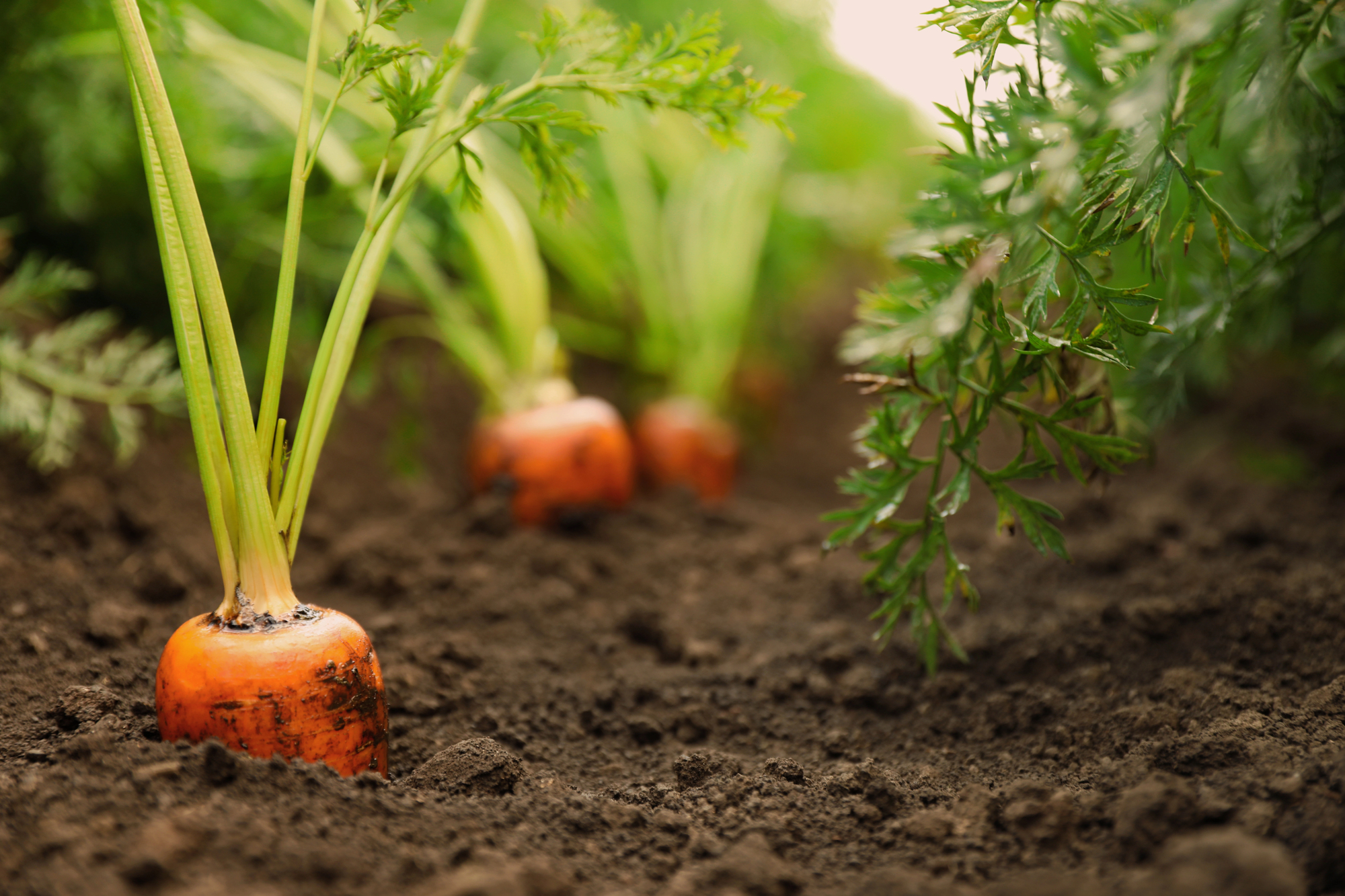Carrot Donation Tracker
Quick Links: How & Where to Grow | Temperature | How to Care For | Harvest Signs | Harvesting | Pests | Companions | Flavor | Preservation | Recipes | Michigan Tips | Fun Facts
🌱 How & Where to Grow Carrots:
- Plant seeds ¼ inch deep when soil reaches 40°F.
- Space seeds ½-1 inch apart in rows 12-18 inches apart.
- Keep soil moist until germination (14-21 days) – patience is key with slow-germinating carrots!
- Sunlight: Full sun (6-8 hours) preferred, tolerates partial shade.
- Soil Type: Carrots need deep, loose, well-drained sandy loam with pH 6.0-6.8.
- Soil Amendment: Work soil deeply (12+ inches) and remove all rocks/clumps to prevent forked roots
Pro tip: Mix carrot seeds with sand for easier sowing, or use seed tape for perfect spacing!
🌡️ Temperature Guidance:
Spring: 40°F minimum. Fall: Plant 10-12 weeks before frost.
- Optimal growing: 60-70°F for sweetest roots.
- Germination: Very slow at 40°F (up to 3 weeks), faster at 60-70°F (7-10 days).
- Carrots become sweeter after exposure to light frosts.
- Can tolerate temperatures down to 20°F with mulch protection.
Michigan’s cool springs mean using row covers can speed germination significantly!
💧 How to Care for:
- Consistent Moisture: Critical during germination – never let soil crust over.
- Watering: Provide 1 inch weekly with deep, infrequent watering for straight roots.
- Mulch: Apply after seedlings emerge to retain moisture and prevent green shoulders.
- Fertilizer: Avoid high nitrogen – use balanced 5-10-10 at planting.
- Thinning: Essential! Thin to 2-3 inches apart when tops are 2 inches tall.
📏 Harvest Signs:
60-75 days maturity. Check shoulder width. Fall carrots sweetest after frost.
- Baby carrots can be harvested at finger-width size.
- Shoulders will be ½-¾ inch wide at maturity for most varieties.
- Bright orange color develops fully at maturity.
- Gently brush soil to check size without disturbing roots.
Don’t wait too long – oversized carrots become woody and lose sweetness!
🧺 Harvesting:
Loosen soil if needed. Pull straight up with twist. Remove tops immediately.
- Always water deeply the day before harvesting for easier pulling.
- Use a digging fork alongside rows in heavy clay soil.
- Twist and pull gently – forcing can break roots.
- Cut tops to ½ inch immediately to prevent moisture loss.
- Don’t wash until ready to use for longest storage.
🪲 Michigan Pests:
Carrot rust fly, wireworms (serious), cutworms, aster yellows.
- Carrot rust fly larvae tunnel through roots – use row covers all season.
- Wireworms are especially problematic in new gardens – rotate crops annually.
- Cutworms sever young seedlings at soil level – use collar barriers.
- Aster yellows causes hairy, bitter roots – control leafhoppers that spread it.
🫱🏽🫲🏼 Companions:
Excellent with tomatoes, lettuce, onions. Radishes mark rows.
- Tomatoes may improve carrot flavor while carrots loosen soil for tomato roots.
- Onions and leeks repel carrot fly.
- Radishes germinate quickly, marking slow carrot rows.
- Lettuce provides living mulch between rows.
- Avoid dill and other umbellifers which can cross-pollinate.
🍴 Flavor:
Sweet, crisp. Fall carrots develop more sugars.
- Baby carrots are tender with mild flavor.
- Summer carrots can be less sweet due to heat stress.
- Fall/winter carrots convert starches to sugars for cold protection.
- Different colors offer unique flavors – purple are slightly spicy, yellow are mild.
- Home-grown carrots have incomparable sweetness compared to store-bought.
🫙 Preservation:
Root cellar in sand (4-6 months), freeze blanched, dehydrate, pressure can.
- Root cellar storage – layer unwashed carrots in damp sand at 32-40°F.
- Refrigerator – store in perforated bags for 4-6 weeks.
- Freezing – blanch sliced carrots 2 minutes, whole baby carrots 5 minutes.
- Pressure canning only – never water bath can.
- Dehydrate slices for soups or grind for carrot powder.
- Leave in ground with heavy mulch for fresh winter harvest.
🧑🏽🍳 Recipes:
Glazed carrots, carrot cake, carrot ginger soup, pickled carrots.
- Roast whole carrots with honey and harissa for a showstopper side.
- Make carrot top chimichurri – don’t waste those nutritious greens!
- Quick-pickle with daikon for Vietnamese banh mi.
- Carrot butter is a unique spread – simmer with spices until jammy.
- Fresh carrot juice needs 2 pounds for one cup – so sweet!
✋🏼 Michigan Tips:
- Use row covers early.
- Mulch fall crops for winter harvest.
- Michigan’s heavy clay needs serious amending – add sand and compost.
- Plant shorter varieties like ‘Paris Market’ if you have shallow or rocky soil.
- Time fall planting for late July to harvest sweet carrots through December.
- Consider raised beds for better drainage and deeper loose soil.
❄️ Overwintering:
- Carrots can survive Michigan winters right in the ground with protection.
- Apply 12-18 inches of straw mulch after ground begins to freeze.
- Cover with row cover or old carpet for extra insulation.
- Mark rows clearly before snow cover.
- Harvest on mild days when soil thaws.
- Overwintered carrots are incredibly sweet – worth the effort!
🧠 Fun Facts:
- Originally purple!
- Baby carrots are cut full-size carrots.
- Carrots were first cultivated in Afghanistan around 900 AD.
- Orange carrots were developed by Dutch farmers in the 16th-17th centuries to honor William of Orange.
- Wild carrots (Queen Anne’s Lace) are the ancestors of modern carrots.
- Carrots are 88% water but packed with beta-carotene.
- The myth that carrots improve night vision came from WWII British propaganda.
- Michigan produces over 1,000 acres of processing carrots annually!


0 Comments